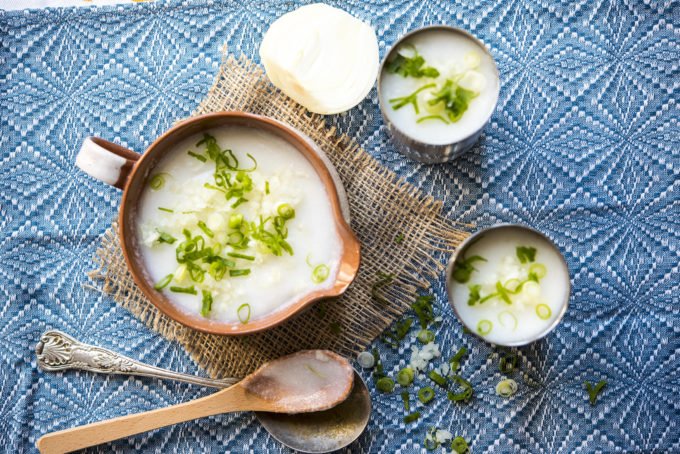
Tracing a Breakfast Lineage Through Time and Across Continents

Tracing a Breakfast Lineage Through Time and Across Continents
Sour Porridge in South Africa
It’s 6:00 a.m. and the pots are bubbling on the wood fire outside. My grandmother—wiry, agile, clad in a faded cotton sari—sits on the red stoep, veranda, in the smallholding in Verulam, north of Durban. Here, indentured laborers who sailed from the port in Madras worked the once-dense sugarcane plantations, her forebears and mine.
In her hands, she cradles an enamel mug of cooled sour porridge flecked with spring onions. From behind a pillar I watch her savor this peace. Before the visiting grandchildren wake up and descend upon the dusty backyard, before her daughters push through the warren-like bedrooms with their questions and chatter. Before the sons who need their lunch tins and cups of tea, she drinks her breakfast of fermented mielie meal (maize flour) gruel. Some mornings, she adds chopped raw onions, and I smell it on her breath when I leave my hiding post and squat close to her.
My mother has a similar memory of my Ayah, her mother, drinking sour porridge in the unrelenting summer heat, managing her brood of 12 children and orchestrating simple meals from the staples of the day. “They had so many to feed, so much of manual labor. The refreshing sour porridge gave her an energy boost,” my mother tells me.
In South Africa, eating plain mielie pap or porridge for breakfast is a common cross-cultural affair. With sugar and milk and a little butter if you can afford it, it’s a staple that’s endured well beyond the introduction of American cereals and Nutella on toast. It’s inexpensive, stretches far and when fermented, introduces a host of health benefits.
South Indian sour porridge, though prepared with the same main ingredient as the traditional fermented drink amaRehwu (spellings vary across ethnic groups) beloved by the late Nelson Mandela, is different. Associated with the Tamil Mariamman prayers for fertility, harvest and health, it’s a nutritious gruel soured without the use of yeast and is flavored with spring onions. Or in the case of my father and grandfathers, pickled green chilies.
South Indians drank a similar workman’s drink called neeragaram, made from fermented leftover rice, which indentured laborers in South Africa had very little access to. However, that drink has essentially disappeared into obscurity. Historian A R Venkatachalapathy attributes the rise of Tamil Nadu’s coffee culture to the decline of neeragaram among laborers. However, coffee drinking did not catch on with the South Indians in South Africa and sour porridge made with maize has endured, marked now by its significance in religious ceremonies.
I think of my Ayah offering me a sip, me turning my nose up at the tart oniony porridge, but knowing, instinctively, that this would become a moment I’d recall for years after her passing.